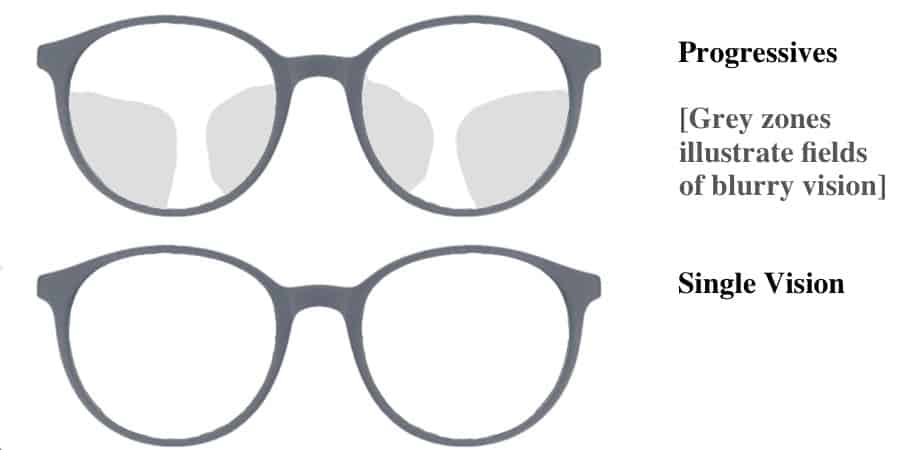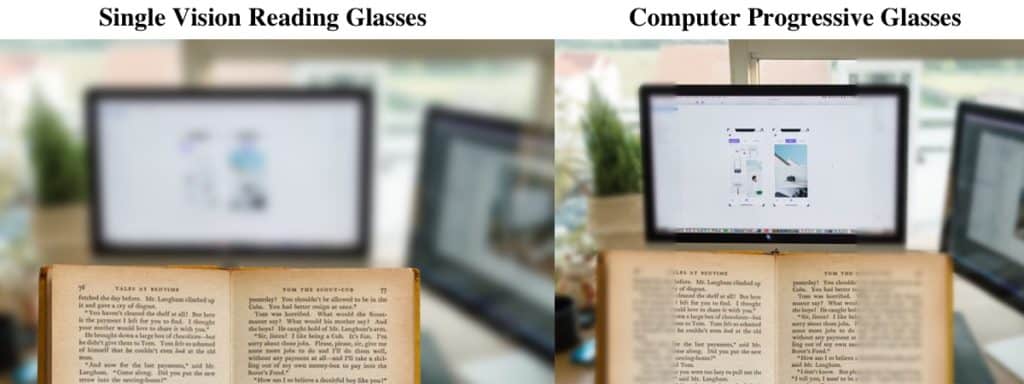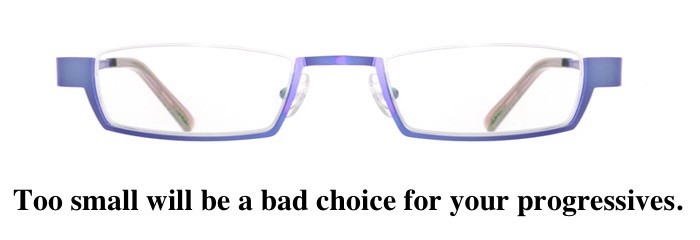In this article, you will learn the comparisons between single vision glasses and progressive glasses. Those comparisons change as you age. Just look at yours.
Single vision lenses provide you with on prescription and they give you the biggest field of view. Compared to single vision lenses progressive glasses have multiple lens powers. They have a reading zone in addition to the distance zone. The fields of view are restricted here but you do not need to switch glasses to see into the distance or read.
What Is the Difference Between Single Vision Glasses and Progressive Glasses?
Progressive lenses generally have their reading zones just in the lower half of the lenses (except for special designs). In contrast, single vision lenses have their reading power all over the lens. So if you are working on something above your head and you need to see some small details progressive lenses will not work. As you can not see through the reading zone in progressives you need to switch to single-vision reading glasses.

Single vision lenses are definitely cheaper than progressive lenses and as you age oftentimes these differences in prices get bigger. In most cases, people see a difference in really high-end progressive glasses to cheaper ones. In single vision glasses, wearers do not necessarily see the difference from a top-notch single vision lens to a lower-priced one.
The reason is single vision lenses hold way fewer distortions in the periphery compared to progressive glasses. So there is oftentimes no need to customize the lens design to the max. Customization also takes time. Single vision lenses are often ready for you in the optical shop when a progressive lens has to be produced for you. In short, the delivery time will be shorter for you with single vision lenses.
You can use your progressive lenses optimally just in an upright posture. As soon as you lay down on your couch and you want to watch a little TV this will lead to blurry vision. The reason is your changed position which forces you to look lower through the lenses on the screen. As soon as you look lower through the progressive lenses reading power kicks in and your progressives the TV screen appears blurry.

However, if you change to an upright position this will not be a problem anymore. In contrast to progressive lenses oftentimes you can position yourself on your couch as comfortable as you want and you can still see clearly with your single vision distance glasses but obviously you can not read with them.
With single vision lenses, you can also just use the center of the lenses to avoid prismatic effects if your prescriptions are very unequal for both eyes. If you were forced to leave that perfect spot to perform eye movements this sometimes could lead to dizziness, headaches, and also blur. But you do not have to perform those eye movements because you just have one prescription all over distributed your single vision lenses and you would not benefit from the eye movements,
That totally changes with progressive glasses. Now you are forced to look down and leave these perfect spots otherwise you will not get into the zone for distance vision or reading. The perfect spot to avoid prismatic effects is always 4mm under the perfect zone for distance vision in your progressive lenses. so you will seldom use this spot when compared to single vision lenses these spots can be centered right in front of your eyes so you have minimal prismatic side effects.
Now that you read about the differences in the lens designs from progressive glasses vs single vision glasses this can affect your frame selection. You will stick to frames when choosing progressive lenses that will provide you with a minimum height of 14mm from the point you are looking through the lenses into the distance to the point you are looking down while you read.
Of course, the possibilities are great with progressive lenses to choose a selection of frames but if you are looking for a very small height for the frame your choices may be really limited with progressive lenses. With single vision lenses, you will not have a problem finding a frame.
If you are in your 40s right now you might notice that reading at close range gets a little bit harder. At this age, you will have an easy time wearing progressive glasses for the first time as they provide you with a little reading power and a wide field of view. Nothing changed much but you can now read more easily. Compared to that you adjust also almost instantly to single vision lenses but if you have them for reading they will make your distance vision blurry.
Some people are very annoyed about the fact they constantly need to switch between single vision glasses to work or read. With progressive glasses, they do not need to switch them in their 40s. They just need to look down and in an instant, they can see totally clear in close range. That is really comfortable.
As you get into your 50s your eyes lose their ability to accommodate the close range more and more. of course, you can compensate for that with more reading power easily but in progressives, the field of views now gets really small in their width of the view. Now oftentimes you can just see 2-3 articles clearly in your newspaper. With your single vision glasses, you can see the whole newspaper clearly from the left to the right.

Even the lowest priced single vision glasses for reading or the distance will provide you with a bigger field of view compared to the very high-end progressive glasses. With more distortions in the lenses, people tend to notice the following in your progressives which will seldom occur with their progressive lenses.
- Restrictive eye movements
- Straight lines appearing bent
- Heaving-to adjust your posture so you can read or see in the distance
All those effects are more common now with progressives as time passed a little more. Now it requires you to adjust even longer to progressive glasses because of these effects. With reading glasses, your adaptation time still will be almost instantaneous. With progressive glasses, it can be a few days up to many times a few weeks.
When you reach your 60s reading power had to be increased a few times since you started with your progressive lenses or your single-vision reading glasses a decade or two ago. The more reading power you have the shorter the distance gets for clear vision with your single-vision reading glasses.
This may force you to change your posture with single vision glasses for reading to get nearer to a screen. Compared to that with computer progressive glasses you do not need to change your posture because a really wide field of view is located in the lens design to give you crystal clear vision for the PC screen and as you look down you get a really comfortable reading area. This typically happens when your reading power Add value gets bigger than +2,00D.
Usually, you need to add another pair of glasses as you age for the computer for example. The same is true for progressive glasses. You oftentimes need other lens designs in addition because just going with progressives will not cut it. But you do not need to put them on and off all the time as you would have to do with your single vision glasses.
I hope this little comparison gave you some insides to evaluate more what you want to get when buying your new glasses. It really comes down to how much your eyes can accommodate to the near range. Just talk to your optician about your hobbies and your work and he will present to you the limitations and benefits of both lens designs specifically tailored to your case.
I wish you a great day.


